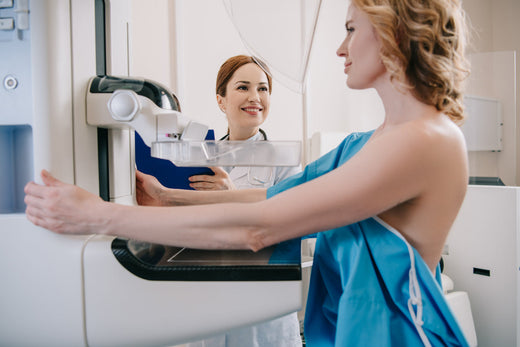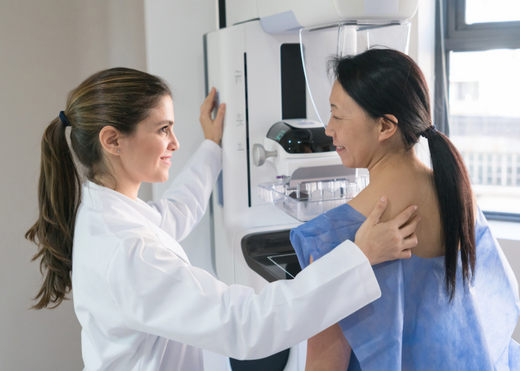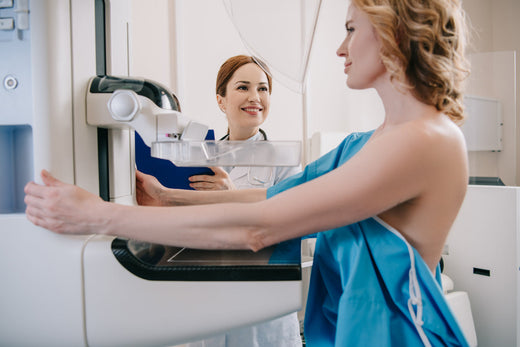Do Mammograms Hurt?
Find out moreA mammogram is an X-ray of the breasts. A specialist radiographer called a mammographer performs a mammogram to identify abnormalities in the breast tissue, such as calcifications, masses, cysts and breast cancer.
In this article, we’ll discuss how a mammogram works, how long it takes, if it’s normal to hurt, and what to expect after a mammogram.
How does a mammogram work?
A breast screening mammogram is an X-ray examination of the breasts. It uses low doses of radiation to detect cancers that are too small to see or feel.
Before your breast screening, your mammographer will take you through what to expect during your mammogram and answer your questions.
You’ll need to be undressed from the waist up and remove any jewellery before your mammogram. During the mammogram, the mammographer will place your breast between two plates. These plates squeeze together to hold your breast still and press it flat while the images are taken. You’ll need to stay as still as possible while the mammographer takes the X-rays to ensure the images come out clearly.
An image of each breast needs to be taken at two different angles, so your breasts and the plates must be positioned in four different ways to take the necessary images.
The four images allow your mammographer to see any unusual changes in your breast tissue. If the mammogram identifies anything suspicious, you will need further testing.
How long does a mammogram take?
A mammogram appointment takes about 30 minutes from start to finish. The mammogram itself will take around 10 minutes.
It may take more or less time, depending on how long the mammographer takes to position your breasts correctly or if any images are unclear and need to be retaken.
Do mammograms hurt?
During a mammogram, your breast is squeezed between two plates to spread the tissue. It enables the X-rays to show any abnormalities in the breast tissue accurately.
Because the breast is being compressed, a mammogram can be uncomfortable and even painful for some people.
Mammogram machines have different-sized compression plates and single-use padding to help accommodate various breast sizes and minimise discomfort. People with smaller breasts may experience a bit more pain than those with larger breasts, as they have less tissue to be squeezed and spread between the plates.
Factors that may affect the level of discomfort felt during a mammogram include:
- The density of your breast tissue
- Breast positioning during screening
- When your period is due
- The mammographer’s skill
For most people, having a mammogram is uncomfortable but not usually unbearable.
How to reduce pain during a mammogram
You can do several things to minimise the discomfort of a mammogram. These include:
- Scheduling your appointment around your period – hormonal changes mean your breasts can be tender, so try to book your mammogram one to two weeks after your period.
- Using pain relief – taking an over-the-counter painkiller 45 to 60 minutes before your appointment can help lessen any discomfort you might feel.
- Communicating your needs – tell your mammographer if you have a low pain tolerance or a chronic pain condition, so they can make your screening as comfortable as possible.
- Decreasing salt intake – salty foods can increase water retention in your body, causing your breasts to bloat, which may make compression more uncomfortable.
- Avoiding caffeine – caffeine in coffee, tea and soft drinks can make your breasts feel tender and, therefore, should be avoided or reduced for one to two weeks before your screening.
- Practising relaxation techniques – breathing exercises and meditation can help you feel more relaxed and reduce any tension in the body due to nerves in the lead-up to your mammogram that can increase discomfort.
If you are nervous about your appointment, speak to your doctor or the specialist taking your mammogram. They will be able to put your mind at ease and help you to feel as comfortable as possible.
Is it normal to have breast pain after a mammogram?
It is completely normal to feel discomfort or pain during a mammogram. The feeling should go away once the mammogram is over and you can return to your daily routine straight after your appointment.
If you found the screening very painful, you may experience discomfort for a couple of days. If this happens, wearing a soft bra with no underwiring can help you feel more comfortable. You can also take painkillers to help relieve any tenderness. Taking a warm bath and applying warm and cold compresses may also help provide relief.
If you’re taking blood thinners or are naturally prone to bruising, you may notice some bruises on your breasts in the days after your mammogram.
When to see a doctor
Tenderness and a small amount of bruising after a mammogram aren’t usually concerning, but you should speak to your doctor if these symptoms last for more than a few days.
When to schedule a mammogram
When you have your mammogram can affect the level of discomfort you’ll experience. Your breasts are more tender just before and during your period. If you have periods, you should have a mammogram seven to 14 days after the first day of your period.
The NHS offers all women between 50 and 71 routine mammograms every three years. If you notice a change in your breasts, at any age, such as a lump, pain, skin appearance or nipple thickening or discharge, talk to your GP immediately — they may refer you for a mammogram or another form of breast screening.
Find out more about when and how regularly you should book breast screenings in our blog post on how often you should have a mammogram.
Check4Cancer offers rapid access appointments for private breast screening mammograms to detect breast cancer at an early stage before changes can be felt in the breast. You don’t need a GP referral and reports are given by highly experienced breast radiologists within three to four weeks. Book your mammogram today.

Professor Simon Russell
Deputy Chief Medical Officer and Advisor for Breast Cancer
Consultant Oncologist at Addenbrooke’s Hospital, Cambridge and Hinchingbrooke Hospital, Huntingdon, Cambridgeshire. Professor of Oncology, University of Rome Medical School. Professor Simon Russell is a Consultant Oncologist at Addenbrooke’s Hospital, Cambridge and Hinchingbrooke Hospital, Huntingdon. He leads the Urological Malignancy Service and has previously been lead clinician for the breast service. He is the lead for Radiotherapy for Genesis Cancer Care, Cambridge. He has served as the secretary of the British Uro-Oncology Group 2003-2015 and remains a Trustee. He was appointed Professor of Oncology at the University of Rome Medical School, Tor Vergata 2015. Simon joined Check4Cancer in 2018.
Find out moreKnowledge and support
Go to all articles
What is Breast Cancer Awareness Month? All You Need to Know
First introduced in 1985, Breast Cancer Awareness Month runs every October with the initial aim of encouraging breast cancer screening...
Read more
Do Mammograms Hurt?
How a mammogram works, how long it takes, if it’s normal to hurt, and what to expect after a mammogram.
Read more
What Happens At A Mammogram?
Looking at what a mammogram detects, how often you should have a breast screening, and what happens before, during and...
Read more